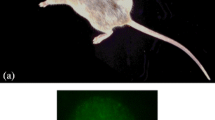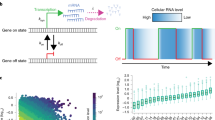Abstract
Mammalian X chromosome inactivation is generally considered to be a good example of stable transcriptional repression; however, there has been no satisfactory evidence for transcriptional control. We have made a test of the hypothesis of transcriptional control by Northern blot analysis of RNA from a woman heterozygous for a mutant Hpt allele which shows no detectable transcription of wildtype mRNA. Cells from this Hpt+ Hpt− woman were separated into HPRT+ and HPRT− subpopulations by selection in HAT or thioguanine. The HPRT+ population (in which the Hpt+ is on the active X) transcribed normal Hpt mRNA, while the HPRT− population (in which the Hpt+ allele is on the inactive X) did not. These results provide strong support for the hypothesis of transcriptional control.
Similar content being viewed by others
Literature cited
Lyon, M.F. (1961).Nature 190:372–373.
Gartler, S.M., and Riggs, A.D. (1983).Annu. Rev. Genet. 17:155–190.
Graves, J.A.M. (1983).Dev. Mammals 5:251–295.
Comings, D.E. (1966).J. Cell Biol. 28:437–441.
Fujita, S., Takeoka, O., Kaku, H., and Nakajima, Y. (1966).Nature 210:446.
Schneider, L.K. (1970).Experientia 26:914–916.
Mann, K., and Mukherjee, B.B. (1970).Can. J. Genet. Cytol. 12:44–51.
Darnell, J.E., Jelinek, W.R., and Molloy, G.R. (1973).Science 181:1215–1221.
Comings, D. (1967).Cytogenetics 6:120–144.
Donald, J.A., and Cooper, D.W. (1977).Aust. J. Biol. Sci. 30:103–114.
Rao, S.R.V., and Arora, P. (1979).Chromosoma 74:241–252.
Lavelle, A.L., and Graves, J.A.M. (1982).Chromosoma 87:469–476.
Francke, U., Felsenstein, J. Gartler, S.M., Migeon, B.R., Dancis, J., Seegmiller, J.E., Bakay, F., and Nyhan, W.L. (1976).Am. J. Hum. Genet. 28:123–137.
Szybalski, W., Szybalska, E.H., and Ragni, G. (1962).Natl. Cancer Inst. Monogr. 7:75–89.
Goto, K., Maeda, S., Kano, Y., and Sugiyama, T. (1978).Chromosoma 66:351–359.
Chirgwin, J.M., Przybyla, A.E., MacDonald, R.J., and Rutter, W.J. (1979).Biochemistry 18:5294–5299.
Lehrach, H., Diamond, D., Wozney, J.M., and Boedtker, H. (1977).Biochemistry 16:4743–4751.
Thomas, P.S. (1980).Proc. Natl. Acad. Sci. U.S.A. 77:5201–5205.
Jolly, D.J., Okayama, H., Berg, P., Esty, A.C., Filpula, D., Bohlen, P., Johnson, G.G., Shively, J.E., Hunkapillar, T., and Friedmann, T. (1983).Proc. Natl. Acad. Sci. U.S.A. 80:477–481.
Stambrook, P.J., Dush, M.K., Trill, J.J., and Tischfield, J.A. (1984).Somat. Cell Mol. Genet. 10:359–367.
Venolia, L., and Gartler, S.M. (1983).Nature 302:82–83.
Romeo, G., and Migeon, B.R. (1975).Humangentik 29:165–170.
Zuna, R.E., and Lehman, J.M. (1977).J. Natl. Cancer Inst. 58:1463–1472.
Goodfellow, P., Banting, G., Sheer, D., Ropers, H.H., Caine, A., Ferguson-Smith, M.A., Povey, S., and Voss, R. (1983).Nature 302:346–349.
Polani, P.E.Hum. Genet. (1982).60:207–211.
Migeon, B.R., Shapiro, L.J., Norum, R.A., Mohandas, T., Axelman, J., and Dabora, R.C. (1982).Nature 299:838–840.
Gartler, S.M., Dyer, K.A., Graves, J.A.M., and Rocci, M. (1985). InChemistry, Biochemistry and Biology of DNA Methylation. Cantoni, G.L., and Razin, A. (eds). Alan R. Liss, New York, pp. 223–235.
Author information
Authors and Affiliations
Rights and permissions
About this article
Cite this article
Graves, J.A.M., Gartler, S.M. Mammalian X chromosome inactivation: Testing the hypothesis of transcriptional control. Somat Cell Mol Genet 12, 275–280 (1986). https://doi.org/10.1007/BF01570786
Received:
Revised:
Issue Date:
DOI: https://doi.org/10.1007/BF01570786




